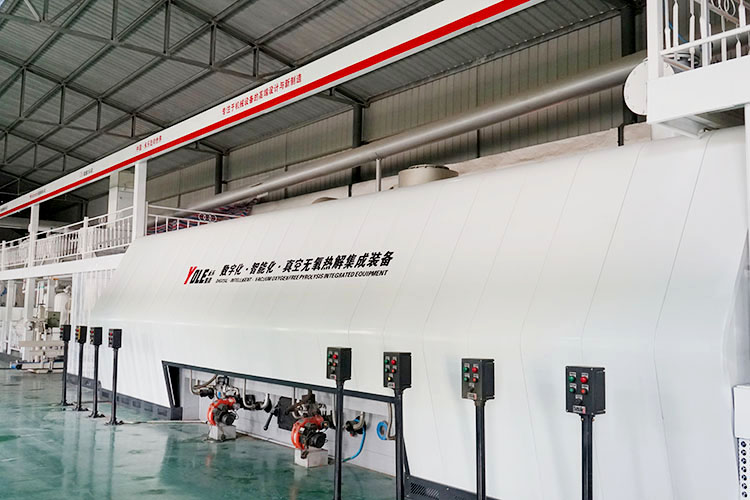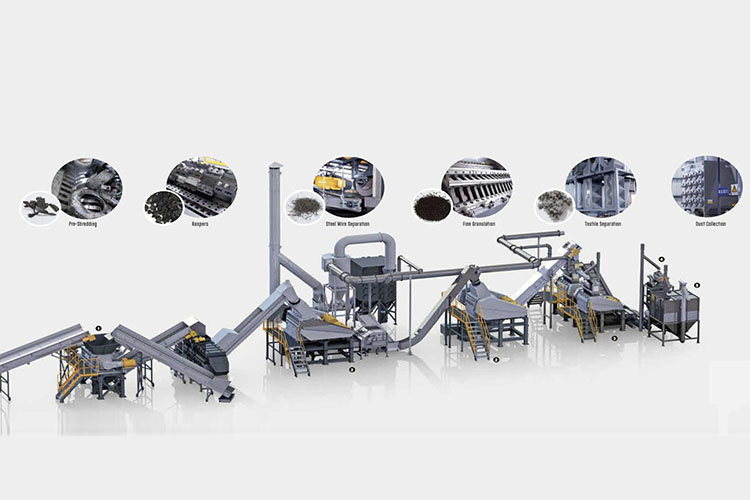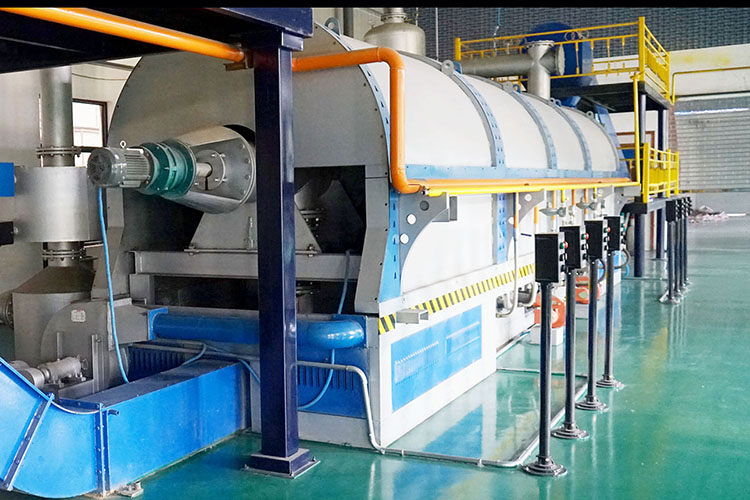Organic solid waste treatment equipment is a type of mechanical equipment specifically designed for treating various types of organic solid waste. These wastes include but are not limited to kitchen waste, garden waste, livestock manure, crop straw, etc. Through physical, chemical, and biological means, these devices can convert waste into useful resources such as compost, biofuels, etc., effectively solving the problems of waste treatment and resource recycling. This article will provide a detailed introduction to several common organic solid waste treatment equipment and their working principles and applications.
Crushing equipment is an indispensable part of the organic solid waste treatment process. Its main function is to break large organic waste into small particles, thereby improving the efficiency of subsequent treatment. Common crushing equipment includes double axis crushers, single axis crushers, and shear crushers. The dual axis crusher tears and shears waste through blades on two parallel axes, suitable for handling harder organic waste such as tree branches and straw. A single axis crusher uses rotating blades to shear waste, suitable for handling softer organic waste such as vegetable leaves and fruit peels. The shear crusher combines the advantages of the above two devices and can handle various types of organic waste.

After crushing, organic waste usually needs to be dehydrated to reduce its volume and improve the efficiency of subsequent treatment. The squeezing and dehydration equipment removes moisture from organic waste through mechanical pressing. Common pressing and dewatering equipment includes screw presses, belt filters, and plate and frame filters. The spiral press compresses waste through rotating spiral blades, suitable for processing waste with high moisture content. The belt filter press squeezes out water through the clamping and pressing of two filter belts, suitable for continuous treatment of large-scale organic waste. The plate and frame filter press squeezes out the moisture in the waste through the clamping and pressing of multiple plates and frames, making it suitable for organic waste with small processing capacity but high treatment efficiency requirements.
The dehydrated organic waste needs to undergo fermentation treatment to achieve the degradation and transformation of organic matter. Fermentation equipment converts organic waste into compost or biogas through a biodegradation process. Common fermentation equipment includes compost fermentation tanks, aerobic fermentation equipment, and anaerobic fermentation equipment. The composting fermentation tank promotes the degradation of organic waste by microorganisms and generates high-quality organic compost by controlling temperature, humidity, and ventilation conditions. Aerobic fermentation equipment promotes the degradation of organic waste by aerobic microorganisms by increasing air supply, making it suitable for treating organic waste with high nitrogen content. Anaerobic fermentation equipment, under anaerobic conditions, converts organic waste into biogas and compost through the action of anaerobic microorganisms, suitable for treating high moisture organic waste.

A bioreactor is a special type of fermentation equipment that utilizes the metabolic activity of microorganisms to degrade organic waste into useful products. Common bioreactors include anaerobic digesters and aerobic reactors. Anaerobic digesters convert organic waste into biogas and compost through the action of anaerobic microorganisms in anaerobic environments. Aerobic reactors degrade organic waste into compost and carbon dioxide through the action of aerobic microorganisms in an aerobic environment. The advantages of bioreactors lie in their high treatment efficiency, low energy consumption, and suitability for large-scale organic waste treatment.
After fermentation and biological reactions, organic waste usually requires solid-liquid separation to improve the efficiency of solid organic matter treatment. The separation equipment separates the solid and liquid parts of organic waste through physical means. Common separation equipment includes solid-liquid separators and centrifuges. The solid-liquid separator separates solids and liquids through a filter and an extrusion device, suitable for treating organic waste with high water content. Centrifuges separate solids and liquids through high-speed rotation, making them suitable for organic waste with small processing volumes but high treatment efficiency requirements.
The separated solid organic waste usually needs to be dried to further reduce its moisture content and make dry organic fertilizers or fuels. Drying equipment evaporates moisture from organic waste through heat treatment. Common drying equipment includes drum dryer, belt dryer and spray dryer. The drum dryer dries waste through a rotating drum and hot air, suitable for handling large amounts of organic waste. Belt dryer dries waste through conveyor belts and hot air, suitable for continuous treatment of large-scale organic waste. The spray dryer dries the waste through high-temperature spray, which is suitable for organic waste with small treatment capacity but high requirements for treatment effect.

The dried organic waste can be made into organic fertilizer for agricultural use. Fertilizer making equipment processes organic waste into organic fertilizers through processes such as mixing, granulation, and screening. Common fertilizer making equipment includes granulators, mixers, and screening machines. The granulator processes waste into granular organic fertilizers through rotating molds and drums. The mixer mixes different components of waste evenly through rotating blades, suitable for preparing homogeneous organic fertilizers. The screening machine separates particles of different sizes through a vibrating screen to ensure the quality of organic fertilizers.
In the process of organic waste treatment, fermentation and biological reactions usually generate waste gas, which contains harmful gases and odors and needs to be treated before being discharged. Gas purification equipment removes harmful components from exhaust gas through physical and chemical methods. Common gas purification equipment includes biofilters, washing towers, and activated carbon adsorbers. Biofilters degrade harmful gases in waste gas through the action of microorganisms. The washing tower removes harmful components from the exhaust gas through spraying and absorption. The activated carbon adsorber removes harmful gases from the exhaust gas through the adsorption effect of activated carbon.
In order to improve the efficiency and effectiveness of organic waste treatment, modern organic solid waste treatment equipment is usually equipped with automatic control systems. The automatic control system monitors and regulates the entire processing process through sensors and computer control. Common automatic control systems include PLC control systems and SCADA systems. The PLC control system precisely controls the operation of the equipment through programming logic control. The SCADA system comprehensively manages the entire processing process through remote monitoring and data analysis.
There are various types of organic solid waste treatment equipment, each with its own characteristics. In practical applications, it is usually necessary to select appropriate equipment for combination and optimization configuration based on specific types of organic waste and treatment objectives. By using these devices reasonably, the problem of organic waste treatment can be effectively solved, achieving the goals of resource recycling and environmental protection.
Yongle Environmental Protection is mainly engaged in the research and development, production and sales of complete sets of technical equipment for organic solid waste disposal and comprehensive utilization. Production and manufacturing, domestic waste treatment equipment, tire pyrolysis equipment, medical waste disposal equipment, hazardous waste disposal equipment, and achieve efficient and comprehensive utilization of resources through independently developed low-temperature anaerobic pyrolysis equipment technology solutions.
Tags:Detailed introduction of organic solid waste treatment equipment,solid waste treatment equipment,YONGLE GROUP
 Latest news
Latest news


























